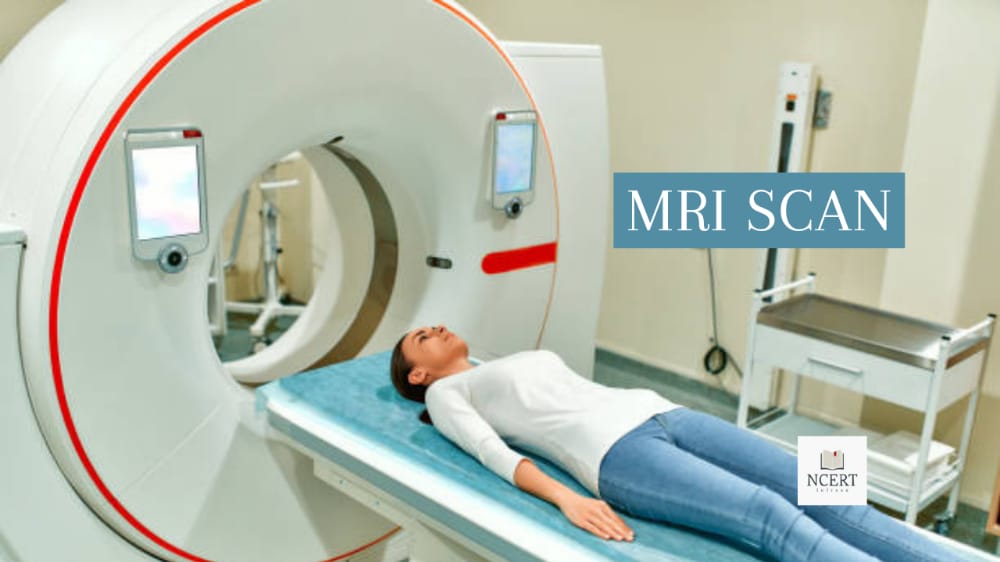The full name of the MRI scan is ‘Magnetic Resonance Imaging‘. For this scan, powerful magnets, radio rays and computers are used, with the help of which the information of the body is obtained through detailed photographs.
Doctors may use this test to perform a physical examination of the patient or to see how the patient is responding to treatment. Radiation is not used in MRI scans like X-ray and CT scan tests.
Since its discovery, doctors and explorers have improved the techniques of using it, which has greatly helped in medical procedures and related discoveries.
MRI scans can be used to examine almost every part of the body, including:
- Brain and spinal cord examination,
- Examination of bones and joints,
- Breast examination,
- Heart and blood vessel examination,
- Examination of other internal organs like the liver, uterus and prostate etc.
The results of an MRI scan are used to test patients’ conditions, design a treatment plan, and see how effective previous treatments have been.
What is MRI Scan
MRI is considered a new technology in the medical field, which is being used since the early 1980s.
In MRI scans, detailed pictures of internal organs and tissues of the body are taken with the help of magnetic power and radio rays, which are then examined on a computer.
Unlike X-rays and other imaging tests, no radiation or harmful substances are used in this test.
Images taken by MRI are much more detailed and informative than other medical imaging test options. Therefore, its quality is better than most commonly used imaging tests (such as X-rays).
What is the purpose of an MRI Scan
The development of MRI has taken the medical world a long way, as it allows doctors to see the internal organs with great accuracy without having to bring any kind of equipment into the body.
In the case of the brain and spinal cord, an MRI scan examines the following:
- Check for damage to blood vessels,
- Check for brain or head injury,
- Cancer screening,
- Multiple sclerosis test,
- Spinal cord injury investigation,
- Stroke check
In the heart and blood vessels, MRI checks for:
- Check for blocked blood vessels,
- Investigation of damage caused by a heart attack,
- Heart disease screening,
- Checking for problems related to the structure of the heart
In the case of bones and joints, MRI scans check for:
- Screening for bone infection
- Damage checks in joints,
- Detection of problems related to the bones and discs of the spine
An MRI scan can also be done to check the health of some internal organs of the body, which includes the following tests:
- Breast (in women)
- Liver
- Kidney
- Ovaries (in women)
- Pancreas
- Prostate (Male)
A special type of MRI is called a ‘functional MRI’ (fMRI), examines brain activity.
This test is used to check which part of the brain is most active when you perform certain tasks. The fMRI scan detects brain-related problems, such as stroke, etc.
If brain surgery is needed in case of epilepsy or a tumor in the brain, then for that brain mapping is done with the help of fMRI. Doctors also use MRI to design a treatment plan.
Before it
The patient may need to do some preparation before having an MRI scan. After going to the hospital, the doctor may ask the patient to change clothes.
Because magnetic force is used in the MRI test, it is important that there is no metal object inside the area to be scanned.
Therefore, the patient is asked to remove any kind of metal jewelery before the MRI scan.
Very powerful magnets are used in MRI. Therefore, MRI scans cannot be done for people whose internal body parts have been replaced.
This is because the powerful magnetic force can dislodge medical implants or affect their functions because they may contain metals.
Therefore, if the patient has undergone an organ transplant, then before going to the scan area, they should talk to the doctors about it. (The patient may also be required to fill out a safety form, in which all details related to metal objects are written)
The list below regarding MRI scans is not final or definitive, but this list helps the radiographer get an idea of what he or she needs to know before the scan.
For example –
- Internal (implanted) defibrillator or pacemaker,
- Ear (cochlear) implant,
- Surgical clips such as the clips used for brain aneurysms.
- Artificial heart valve,
- Medicine infusion port,
- Metal joints or artificial limbs,
- Implanted nerve stimulator,
- Pins, screws, plates, stents and surgical staples.
If ever a small piece of metal has entered the patient’s eye or body, then also tell the radiographer about it.
In some cases, an X-ray scan is needed before an MRI to confirm whether the patient is safe to undergo an MRI.
Sometimes contrast is injected into the patient’s body with the help of ‘intravenous’ so that the picture of certain tissues can be more clear.
The radiologist can talk to the patient during the MRI scan and explain the scan process.
During MRI Scan
A special contrast dye is injected into the vein of the patient’s arm before the MRI scan is performed. With the help of this dye, doctors are able to see the internal structure of the body better. The dye used for MRI is called gadolinium.
During the scan, the patient is made to lie on a table-like object, which goes inside the MRI machine. Bandages may also be needed to prevent the patient from moving during this test.
During MRI, if needed, the whole body is also put inside the machine. When not needed, only the necessary part is inserted inside the machine.
Once the MRI scanner is in, the MRI technician interacts with the patient to make sure the patient is comfortable. The scan is not started until the patient is ready (mentally).
The patient has to remain silent and still during the start of the scan. Because shaking can mess up the scan pictures. Because the camera only takes the picture of the moving object. Scanner noise is very loud.
If the patient is not comfortable while the scan is going on, they can also talk to the technician in the middle with the help of the intercom and request to stop.
The MRI machine creates a powerful magnetic field inside the body. The computer receives the signals from the MRI and combines them to produce images. A thin layer of the body is formed in every picture.
During MRI test, the patient may hear a loud noise. This loud sound generates energy for the machine to take pictures of the inside of the body. To avoid this noise, the doctor may give ear plugs or headphones.
A twitching sensation may be felt during the test, which occurs when the MRI stimulates nerves inside the body.
After MRI Scan
After the MRI test, it does not have any effect on the body. As soon as the test is complete, you can go about your daily activities immediately.
The pictures taken during the test are examined by the specialist (Radiologist). After that the radiologist sends the report to the doctor.
What are the risks of MRI scan
MRI is a painless and safe procedure. For those who have the problem of ‘claustrophobia‘, it can be a little uncomfortable.
But with the help of radiographer support, it is possible for most people to do this. It may be a bit comfortable to walk into the scanner with your feet during the scan, although this may not always be possible.
An MRI scan does not involve exposing the body to X-ray radiation. That means that people who are particularly vulnerable to the effects of radiation, such as pregnant women and children, can get an MRI scan if needed.
However, not everyone can have an MRI scan, for example for people who have had organ transplants. Such as a person with a pacemaker (a battery-operated device that controls the uncontrolled heartbeat).
Much research has been done on whether the magnetic field and radio waves used during MRI scans can pose a risk to the human body. No evidence was found to suggest a reason for the risk. This means that MRI is by far the safest procedure available.
What do the results of this scan mean
Normal Result:
A normal MRI scan means that the part of your body that was scanned has not found any abnormalities, that is, you do not have any health problems for which the scan was done.
Abnormal Result:
The result of an MRI scan is prepared on the basis of the signals received from that part of the body during the scan.
For example, cancer cells give different signals than healthy tissue. It is better to contact the doctor with your report, he will explain you the scan report thoroughly.




